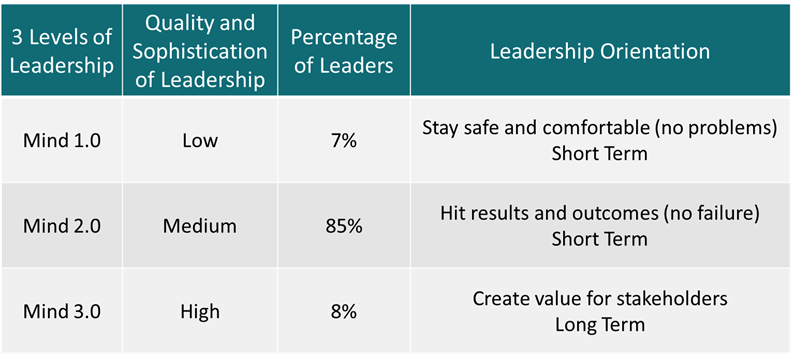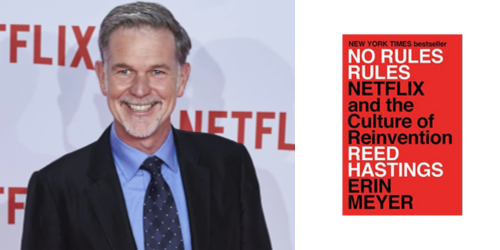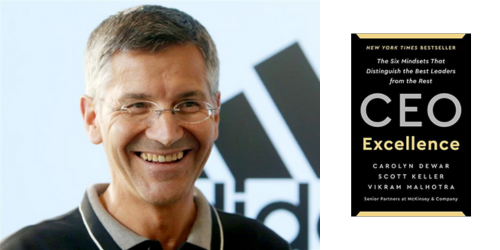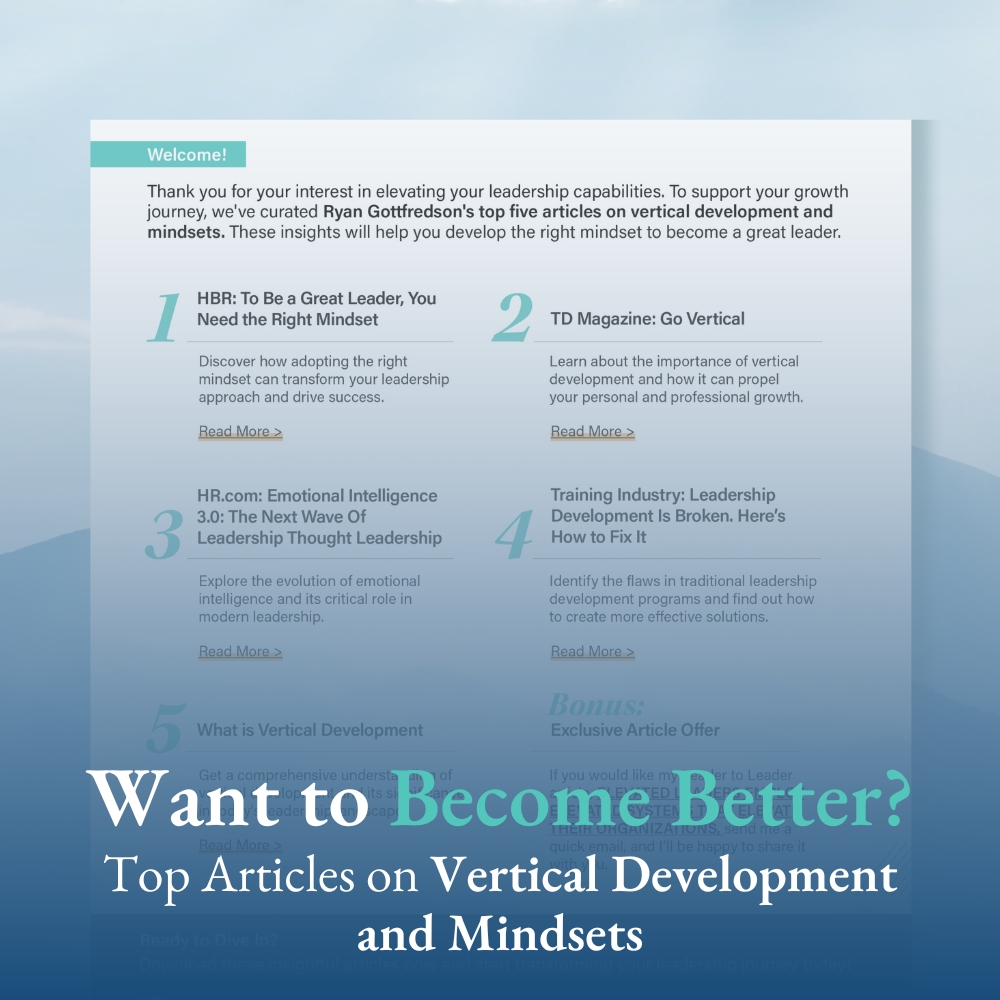Knowing about the concept of vertical development, I have come to learn that leaders can operate from three different levels of cognitive and emotional sophistication:

Recognizing that only 8% of leaders operate at the highest level of leadership, I have been on a mission to identify:
- Exemplars of Mind 3.0 leaders
- What Mind 3.0 leaders do differently than Mind 1.0 or Mind 2.0 leaders
And, I have identified a clear pattern. Let me see if you can spot it too.
Mind 3.0 Leaders Examples
Reed Hastings at Netflix

In his book, No Rules Rules, Reed Hastings says that setting the context for his leaders is something he does every quarter at their Quarterly Business Review Meetings. Of these meetings, he writes:
“The number one goal for these meetings is to make sure that all leaders across the company are highly aligned on what I call our North Star: the direction we are running in.”
Alan Mulally at Ford

When Alan Mulally stepped into the CEO position at Ford, he said, “An organization, to render any service so widely useful, must be large in scope as well as great in purpose.”
And, something that caught his attention early into his tenure was an old Ford advertisement from 1925, which had the tagline: “Opening the highways to all mankind.”
Writing about the impact this had on Mulally, Bryce Hoffman wrote in American Icon:
“This was exactly what Mulally had been looking for—a polestar to guide his transformation of Ford, a touchstone that he could return to in times of doubt.”
Satya Nadella at Microsoft

Consider the following from Satya Nadella’s book, Hit Refresh:
“When Microsoft’s board of directors announced that I would become CEO, I put the company’s culture at the top of our agenda. I said that we needed to rediscover the soul of Microsoft, our reason for being.”
“I have come to understand that my primary job is to curate our culture so that one hundred thousand inspired minds—Microsoft’s employees—can better shape our future.”
“The team I inherited was more like a group of individuals… Each leader in the group was, in essence, CEO of a self-sustaining business. Each lived and operated in a silo.”
“To break out of this impasse, I met with everyone…individually, taking their pulse, asking questions and listening. Together, we needed to develop a North Star.”
To develop Microsoft’s purpose statement, he spent the first year of his tenure listening to employees. Of this, he wrote:
“Listening was the most important thing I accomplished each day because it would build the foundation of my leadership for years to come.”
Herbert Hainer at Adidas

In a CEO Excellence, an authorship team from McKinsey & Company highlights the leadership of Herbert Hainer at Adidas. They quote him as saying:
“The goal wasn’t to be the biggest and the richest, it was to start creating products that help athletes perform better, so the runner can run faster, the tennis player and the soccer player can play better. If we did that and provided good service to our consumers, the financials would follow. All we had to do was help people achieve their personal best… I wanted to give the company the belief that this was more than just a revenue game and we are more than just a revenue company.”
The Number One Priority of Most Mind 3.0 Leaders
From reading these examples, are you picking up on a theme?
They all prioritize the identification of a clear, inspirational, and stakeholder-centric purpose.
Here are examples of the purpose statements that these leaders have utilized:
- Netflix: We want to entertain the world
- Ford: Open the highways to all mankind
- Ford: Create long-term value and profitable growth for all of Ford’s stakeholders (e.g., customers, dealers, employees, suppliers, community, etc.)
- Microsoft: To empower every person and every organization on the planet to achieve more
- Adidas: Through sport, we have the power to change lives
I’ll let you evaluate the degree to which they are clear, inspirational, and stakeholder-centric.
Why?
Recognizing this, I have asked myself, “Why is it that the most sophisticated leaders prioritize purpose?”
I want to share some of the reasons why I think leaders do this. If you have other ideas that you think I should consider, please let me know.
- Reason #1: A clear, inspirational, and stakeholder-centric purpose is the chief foundational cornerstone of a healthy, service-oriented, and innovative culture
- Reason #2: A clear, inspirational, and stakeholder-centric purpose helps to ensure all divisions, leaders, and employees are on the same page and working together to accomplish the purpose
- Reason #3: A clear, inspirational, and stakeholder-centric purpose becomes a filter by which all decisions are made
- Reason #4: A clear, inspirational, and stakeholder-centric purpose helps leaders prioritize the most important things to focus on, not necessarily the most urgent things to focus on
- Reason #5: A clear, inspirational, and stakeholder-centric purpose helps leaders to clearly identify (1) what to change, (2) what to change to, and (3) how to create the change (helping the organization continually elevate and be more agile, innovative, and future-ready)
When a clear, inspirational, and stakeholder-centric purpose is not present in an organization, here is what commonly occurs:
- The leaders and employees become short-term minded and focused on themselves: either staying safe and comfortable (Mind 1.0) or on accomplishing outcomes that will help them stand out (Mind 2.0).
- A culture of silos become predominant, and rather than a leadership team working as a team, they operate as a collection of individuals who are fighting for the resources and accomplishments of their division’s priorities.
- The organization tend to alter direction based on the needs of the moment.
- Organizational leaders end up focusing, not on what is most important, but what is most urgent, putting them in a short-term orientation and making them functional “fire fighters” as opposed to strategic leaders.
- Leaders and employees are more inclined to focus on doing what is best for them, as opposed to what is best for the customer, which means that leaders and employees are less willing to do the uncomfortable things that are necessary for agility, innovation, and future-readiness.
Do you have any of these issues in your organization?
Want Help with Your Organization’s Purpose Statement?
When I work with executive teams on elevated leadership and their vertical development, they want to know how Mind 3.0 leaders differ from Mind 2.0 leaders. And, I share that one of the primary differences is that Mind 3.0 leaders develop a clear, inspirational, and stakeholder-centric purpose statement, while Mind 2.0 leaders don’t.
At that point, they quickly introspect about their organization’s purpose statement, and generally either find it missing or wanting. So, it has become quite natural for me to work with executive teams to develop a clear, inspirational, and stakeholder-centric purpose statement.
If you would like my assistance in helping your organization develop a clear, inspirational, and stakeholder-centric purpose, let’s connect.











2 Responses
Great article Ryan! I love helping entrepreneurial leadership teams to figure out their “Core Focus”. The noble purpose that’s bigger than any individual in the company. It’s the “get out of bed on the morning statement. ” It evokes an emotional “Aha!” Along with company core values, it is the soul of the company!
Thank you, Chris! And, agreed!